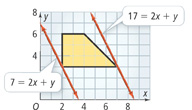3-4 Linear Programming
Objective
To solve problems using linear programming
 Lesson Vocabulary
Lesson Vocabulary
- constraint
- linear programming
- feasible region
- objective function
In the Solve It, you maximized your tomato production given some limits, or constraints. Linear programming is a method for finding a minimum or maximum value of some quantity, given a set of constraints.
Essential Understanding Some real-world problems involve multiple linear relationships. Linear programming accounts for all of these linear relationships and gives the solution to the problem.
The constraints in a linear programming situation form a system of inequalities, like the one below. The graph of the system is the feasible region. It contains all the points that satisfy all the constraints.

The quantity you are trying to maximize or minimize is modeled with an objective function. Often this quantity is cost or profit. Suppose the objective function is C = 2x + y.
Graphs of the objective function for various values of C are parallel lines. Lines closer to the origin represent smaller values of C.
The graphs of the equations 7 = 2x + y and 17 = 2x + y intersect the feasible region at (2, 3) and (7, 3). These vertices of the feasible represent the least and the greatest values for the objective function.

Table of Contents
- 5-1 Polynomial Functions
- 5-2 Polynomials, Linear Factors, and Zeros
- 5-3 Solving Polynomial Equations
- 5-4 Dividing Polynomials
- 5-5 Theorems About Roots of Polynomial Equations
- 5-6 The Fundamental Theorem of Algebra
- 5-7 The Binomial Theorem
- 5-8 Polynomial Models in the Real World
- 5-9 Transforming Polynomial Functions





